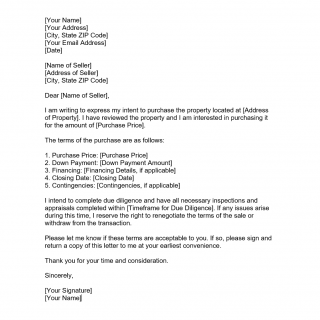Letter of Intent for Real Estate Purchase
A Letter of Intent for Real Estate Purchase is a document that outlines the initial agreement between a buyer and a seller regarding the sale of a property. This letter is used to express the buyer's intention to purchase the property and outlines the terms and conditions of the proposed sale.
The letter typically consists of three sections: the introduction, the body, and the conclusion. In the introduction, the letter identifies the parties involved in the transaction, the property being sold, and the proposed purchase price. The body of the letter elaborates on the terms and conditions of the sale, including any contingencies, financing arrangements, and timelines. The conclusion of the letter includes the signatures of both the buyer and the seller, indicating their agreement to the terms outlined in the letter.
The important fields in the letter include the purchase price, down payment, closing date, contingencies, and financing arrangements. The letter must also include the legal description of the property, including the address and any relevant zoning or land use restrictions.
The Letter of Intent for Real Estate Purchase is commonly used in real estate transactions, particularly for commercial properties. It is used to outline the initial agreement between the buyer and seller before the formal purchase agreement is drafted. The letter provides a framework for negotiations and can help to facilitate the transaction by clarifying the terms of the sale.
When compiling the letter, it's important to consider the legal and financial implications of the proposed sale. Both parties should seek legal and financial advice to ensure that the terms of the sale are fair and reasonable.
Letter of Intent for Real Estate Purchase sample
[Name of Seller]
[Address of Seller]
[City, State ZIP Code]Dear [Name of Seller],
I am writing to express my intent to purchase the property located at [Address of Property]. I have reviewed the property and I am interested in purchasing it for the amount of [Purchase Price].
The terms of the purchase are as follows:
1. Purchase Price: [Purchase Price]
2. Down Payment: [Down Payment Amount]
3. Financing: [Financing Details, if applicable]
4. Closing Date: [Closing Date]
5. Contingencies: [Contingencies, if applicable]I intend to complete due diligence and have all necessary inspections and appraisals completed within [Timeframe for Due Diligence]. If any issues arise during this time, I reserve the right to renegotiate the terms of the sale or withdraw from the transaction.
Please let me know if these terms are acceptable to you. If so, please sign and return a copy of this letter to me at your earliest convenience.
Thank you for your time and consideration.
Sincerely,
[Your Signature]
[Your Name]
The benefits of using a Letter of Intent for Real Estate Purchase include establishing the framework for negotiations, clarifying the terms of the sale, and providing a basis for future legal action if necessary. However, there are also risks associated with using this type of letter, including the possibility of negotiations breaking down and the potential for legal disputes.
Related forms include the Purchase Agreement, which is a more detailed and comprehensive document that outlines the terms and conditions of the sale. Analogues include the Memorandum of Understanding and the Term Sheet, which are used in a variety of business transactions to outline the initial terms of the deal.
The main difference between the Letter of Intent for Real Estate Purchase and other forms is its specificity to real estate transactions. The letter is used to outline the initial agreement between the buyer and seller before the formal purchase agreement is drafted.
The Letter of Intent for Real Estate Purchase can influence the future of the participants by establishing the terms of the sale and providing a basis for future legal action if necessary. The letter can also help to facilitate the transaction by clarifying the terms of the sale and providing a framework for negotiations.
The letter is typically submitted to the seller or their representative for review and signature. Once signed by both parties, the letter is considered a binding agreement and should be stored with other important legal documents related to the transaction.

